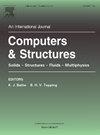基于机器学习的面内荷载砌体墙体材料均匀化技术
IF 4.4
2区 工程技术
Q1 COMPUTER SCIENCE, INTERDISCIPLINARY APPLICATIONS
引用次数: 0
摘要
近年来,分析砌体结构的计算方法取得了重大进展。在有限元方法中,两种主要的方法已经获得了牵引力:微观和宏观尺度建模,以及随后通过基于均质理论和代表性体积单元概念的多尺度方法将它们集成。虽然微尺度和多尺度方法提供了高保真度,但它们通常伴随着大量的计算负担。另一方面,在宏观尺度上校准均质材料参数对实际工程问题提出了挑战。机器学习技术已经成为使用来自各个领域的大量数据集来训练模型的强大工具。在此背景下,我们建议利用机器学习方法开发一种新的均匀化策略,用于砌体结构的面内分析。该策略涉及使用微尺度分析得出的相关数据自动校准连续非线性损伤本构律和适当的屈服准则。优化过程不仅提高了材料参数,而且改进了屈服准则和损伤演化规律,以更好地与现有数据一致。为了实现这一目标,创建了一个虚拟实验室来进行微观模型模拟,以解释组成材料的个体行为。随后,采用数据各向同性过程将结果与典型的各向同性本构模型相协调。接下来,执行了一种最小化微观和宏观尺度之间内部耗散功差异的优化算法。我们将这种技术应用于佛兰德粘结砌体墙的面内均匀化。评估实例,包括剪切和压缩试验的模拟,与整个结构的微观建模相比,证明了该方法的准确性。本文章由计算机程序翻译,如有差异,请以英文原文为准。
A machine learning based material homogenization technique for in-plane loaded masonry walls
In recent years, significant advancements have been made in computational methods for analyzing masonry structures. Within the Finite Element Method, two primary approaches have gained traction: Micro and Macro Scale modeling, and their subsequent integration via Multi-scale methods based on homogenization theory and the representative volume element concept. While Micro and Multi-scale approaches offer high fidelity, they often come with a substantial computational burden. On the other hand, calibrating homogenized material parameters in Macro-scale approaches presents challenges for practical engineering problems.
Machine learning techniques have emerged as powerful tools for training models using vast datasets from various domains. In this context, we propose leveraging Machine Learning methods to develop a novel homogenization strategy for the in-plane analysis of masonry structures. This strategy involves automatically calibrating a continuum nonlinear damage constitutive law and an appropriate yield criteria using relevant data derived from Micro-scale analysis. The optimization process not only enhances material parameters but also refines yield criteria and damage evolution laws to better align with existing data.
To achieve this, a virtual laboratory is created to conduct micro-model simulations that account for the individual behaviors of constituent materials. Subsequently, a data isotropization process is employed to reconcile the results with typical isotropic constitutive models. Next, an optimization algorithm that minimizes the difference of internal dissipated work between the micro and macro scales is executed.
We apply this technique to the in-plane homogenization of a Flemish bond masonry wall. Evaluation examples, including simulations of shear and compression tests, demonstrate the method’s accuracy compared to micro modeling of the entire structure.
求助全文
通过发布文献求助,成功后即可免费获取论文全文。
去求助
来源期刊

Computers & Structures
工程技术-工程:土木
CiteScore
8.80
自引率
6.40%
发文量
122
审稿时长
33 days
期刊介绍:
Computers & Structures publishes advances in the development and use of computational methods for the solution of problems in engineering and the sciences. The range of appropriate contributions is wide, and includes papers on establishing appropriate mathematical models and their numerical solution in all areas of mechanics. The journal also includes articles that present a substantial review of a field in the topics of the journal.
 求助内容:
求助内容: 应助结果提醒方式:
应助结果提醒方式:


